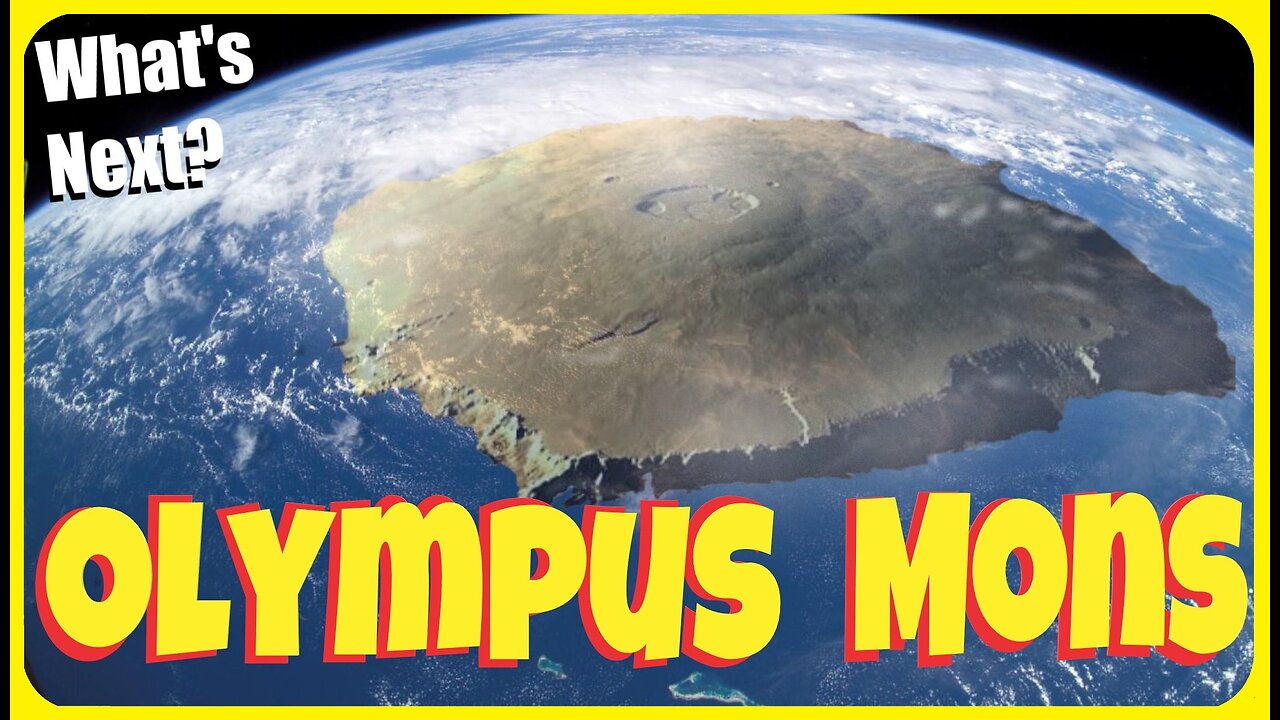Premium Only Content

OLYMPUS MONS was an ISLAND?!?
As a shield volcano, Olympus Mons resembles the shape of the large volcanoes making up the Hawaiian Islands. The edifice is about 600 km (370 mi) wide.[13] Because the mountain is so large, with complex structure at its edges, allocating a height to it is difficult. Olympus Mons stands 21 km (13 mi) above the Mars global datum[specify], and its local relief, from the foot of the cliffs which form its northwest margin to its peak, is over 21 km (13 mi)[5] (a little over twice the height of Mauna Kea as measured from its base on the ocean floor). The total elevation change from the plains of Amazonis Planitia, over 1,000 km (620 mi) to the northwest, to the summit approaches 26 km (16 mi).[3] The summit of the mountain has six nested calderas (collapsed craters) forming an irregular depression 60 km (37 mi) × 80 km (50 mi) across[14] and up to 3.2 km (2.0 mi) deep.[15] The volcano's outer edge consists of an escarpment, or cliff, up to 8 km (5.0 mi) tall (although obscured by lava flows in places), a feature unique among the shield volcanoes of Mars, which may have been created by enormous flank landslides.[16] Olympus Mons covers an area of about 300,000 km2 (120,000 sq mi),[17] which is approximately the size of Italy or the Philippines, and it is supported by a 70 km (43 mi) thick lithosphere. The extraordinary size of Olympus Mons is likely because Mars lacks mobile tectonic plates. Unlike on Earth, the crust of Mars remains fixed over a stationary hotspot, and a volcano can continue to discharge lava until it reaches an enormous height.[18]
Being a shield volcano, Olympus Mons has a very gently sloping profile. The average slope on the volcano's flanks is only 5%.[15] Slopes are steepest near the middle part of the flanks and grow shallower toward the base, giving the flanks a concave upward profile. Its flanks are shallower and extend farther from the summit in the northwestern direction than they do to the southeast. The volcano's shape and profile have been likened to a "circus tent" held up by a single pole that is shifted off center.[19]
Due to the size and shallow slopes of Olympus Mons, an observer standing on the Martian surface would be unable to view the entire profile of the volcano, even from a great distance. The curvature of the planet and the volcano itself would obscure such a synoptic view.[20] Similarly, an observer near the summit would be unaware of standing on a very high mountain, as the slope of the volcano would extend far beyond the horizon, a mere 3 kilometers away.[21]
The typical atmospheric pressure at the top of Olympus Mons is 72 pascals, about 12% of the average Martian surface pressure of 600 pascals.[22][23] Both are exceedingly low by terrestrial standards; by comparison, the atmospheric pressure at the summit of Mount Everest is 32,000 pascals, or about 32% of Earth's sea level pressure.[24] Even so, high-altitude orographic clouds frequently drift over the Olympus Mons summit, and airborne Martian dust is still present.[25] Although the average Martian surface atmospheric pressure is less than one percent of Earth's, the much lower gravity of Mars increases the atmosphere's scale height; in other words, Mars's atmosphere is expansive and does not drop off in density with height as sharply as Earth's.
The composition of Olympus Mons is approximately 44% silicates, 17.5% iron oxides (which give the planet its red coloration), 7% aluminum, 6% magnesium, 6% calcium, and particularly high proportions of sulfur dioxide with 7%. These results point to the surface being largely composed of basalts and other mafic rocks, which would have erupted as low viscosity lava flows and hence lead to the low gradients on the surface of the planet.
Olympus Mons is an unlikely landing location for automated space probes in the near future. The high elevations preclude parachute-assisted landings because the atmosphere is insufficiently dense to slow the spacecraft down. Moreover, Olympus Mons stands in one of the dustiest regions of Mars. A mantle of fine dust obscures the underlying bedrock, possibly making rock samples hard to come by and likely posing a significant obstacle for rovers.
Social Links
YouTube: https://www.youtube.com/channel/UC4lzZ4Tyhkzl582_5jqW3rA
Rumble: https://rumble.com/c/WHATSNEXTVIDS
TikTok: https://www.tiktok.com/@whatsnextvids?lang=en
Twitter: https://twitter.com/WhatsNe75388303
ODYSEE: https://odysee.com/@WhatsNext:5?view=content
Please Support Me
Patreon: https://www.patreon.com/user?u=37594401
Buy Me A Coffee?: https://www.buymeacoffee.com/whats.next
Donate With Cash App: https://cash.app/$YTpayments
-
 11:59
11:59
Bearing
8 hours agoCRAZY TikTok Lady's Reaction to Donald Trump's Inauguration 🤣
1.45K19 -
 LIVE
LIVE
Battleground with Sean Parnell
3 hours agoPresident Trump Is On FIRE w/ Savage Rich Baris
2,189 watching -
 6:51
6:51
Chef Donny
4 hours agoMaking Omelets With Dave Portnoy | What's For Lunch
15.7K2 -
 LIVE
LIVE
Film Threat
18 hours agoSECTION 31 REVIEW! BUT IS IT STAR TREK? | Hollywood on the Rocks
150 watching -
 11:16
11:16
Tactical Advisor
5 hours agoNew Aimpoint/Glock COA Optic (FIRST LOOK)
8.32K2 -
 3:53
3:53
SLS - Street League Skateboarding
5 days agoFrom ABQ to LA - Mariah Duran’s Journey | Kona Big Wave “Beyond The Ride” Part 2
17.6K2 -
 1:19:12
1:19:12
Mally_Mouse
20 hours agoLet's Yap About It - LIVE!
14K2 -
 16:47
16:47
Neil McCoy-Ward
9 hours ago"We've Never Seen Anything Like It!!!" (🇬🇧 Says Private Jet Pilot)
31.2K13 -
 DVR
DVR
G2G Gaming Channel
7 hours agoSmite&Fortnite, Chancletazo&Helmet . Same thing if you ask me!! #RumbleGaming
19.3K2 -
 1:28:06
1:28:06
Russell Brand
5 hours agoInside Trump’s Inauguration: Media Frenzy, Pardons, and Power Plays – SF524
174K96